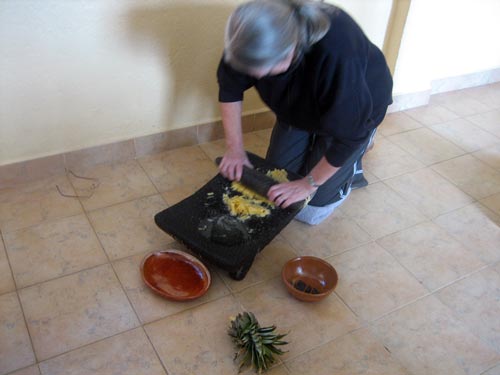By Brenna Goth/CIMMYT

Food historian Rachel Laudan will explain wheat’s impact on world history at the Borlaug Summit on Wheat for Food Security. The Summit, which will be held in Ciudad Obregón, Sonora, Mexico, in March, will feature Laudan’s lecture “Wheat: The Grain at the Center of Civilization.”
Wheat, used in many of the most popular dishes across the globe, has changed the world, according to Laudan.
“No one would have predicted this of the hard-to-process seeds of this finicky, low- yielding grass,” she writes in a preview to her talk. “Nor would they have predicted that processing wheat would have encouraged new forms of economic organization, expressed political and social status and symbolized moral and religious beliefs.”
She recently released the book Cuisine and Empire: Cooking in World History, a story of how food is interconnected with economies, beliefs, social structures and politics throughout time and across the world. The book is a finalist for the International Association of Culinary Professionals 2014 Food Writing Awards. Laudan describes her inspiration on her blog.
Here, Laudan has provided us with an excerpt of the book focused on the difficulties of grinding wheat:
When I was a little girl, my father decided to make some flour from the wheat we had grown on the farm. He tried pounding it with a pestle and mortar but all he got was broken grains, not flour. He put it through the hand mincer screwed to the edge of the table with the same result. Finally, he attacked it with a hammer on the flagstone floor. After he gave up, defeated, my mother cleared up the mess. It was sobering to realize that if the commercial millers vanished, we could have starved even with barns full of sacks of wheat.
To turn wheat into flour, you have to shear, not pound, the hard grains, which requires a grindstone, as the people of Lake Kinneret had discovered. A friend in Mexico, where hand grinding still goes on, showed me how it worked. She knelt at the upper end of a grindstone, called a metate – a saddle-shaped platform on three inverted pyramidal legs, hewn from a single piece of volcanic rock. She mounded a handful of barley, took the mano, a stone shaped like a squared-off rolling pin, in both hands with her thumbs facing back to nudge the grain into place, and, using the whole weight of her upper body, sheared the mano over the grain. After half a dozen passes, she had broken the grains, which now clustered at the bottom end of the metate. Carefully scraping them up with her fingertips, she moved them back to the top, and started shearing again, this time producing white streaks of flour. By the time she had sheared the grain from top to bottom five or six times, she had produced a handful of flour.
Grinding may look easy, and it is, for the first ten minutes. To grind a quantity of grain, though, as I found out when I tried, takes skill, control, physical strength, and time. I was quickly panting, sweaty, and dizzy, my hair in my eyes, and the mano slipping at awkward angles. Grinding is hard on the knees, hips, back, shoulders, and elbows, causing arthritis and bone damage. Grinding is lonely, too exhausting to allow for chatter. Kneeling to grind with the breasts swinging can be seen as submissive, demeaning, and sexually provocative, as lascivious eighteenth- and nineteenth-century illustrations of Mexican women grinding make clear. The heavy labor was relegated to women, convicts, and slaves, called “grinding slaves” in the technical language of seventh-century English court documents. Even today Mexican women in remote villages grind five hours daily to prepare enough maize for a family of five or six. For generation upon generation of grinders in the bread-eating parts of the world, the author of Genesis (3:19) had it nailed. “In the sweat of thy face shalt thou eat bread, till thou return unto the ground; for out of it wast thou taken: for dust thou art, and unto dust shalt thou return.”
You can purchase the book through the University of California Press or Amazon. For more thoughts from Rachel Laudan, check out her website and read her blog.
See all of the Summit speakers here.
 Nutrition, health and food security
Nutrition, health and food security 
